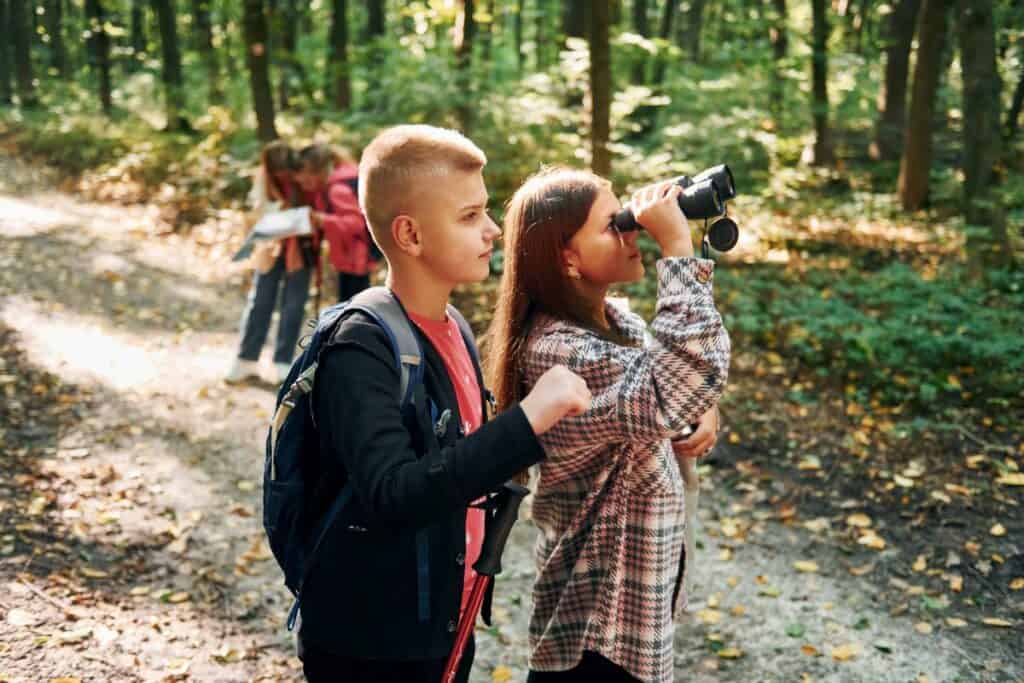Wilderness therapy is a unique approach to promoting mental health and well-being through the use of outdoor adventures and experiences.
It combines traditional therapeutic modalities, such as individual and group counseling, with experiential learning in a natural setting.
This approach has gained significant attention and popularity in recent years due to its proven effectiveness in treating various mental health conditions and promoting personal growth.
Often referred to as “adventure therapy” or “wilderness experience programs,” wilderness therapy aims to provide a supportive and safe environment for participants to explore their emotions, develop interpersonal skills, and build self-confidence.
Programs typically involve a range of outdoor activities like hiking, camping, and team-building exercises.
They are led by trained professionals, including mental health clinicians and wilderness guides, who help participants navigate both the physical and emotional challenges of the experience.
Understanding Wilderness Therapy

Wilderness therapy is a form of psychotherapy that combines traditional mental health practices with outdoor activities and experiences.
It is often referred to as outdoor behavioral healthcare, as it aims to treat a range of emotional, behavioral, and psychiatric issues.
The core of wilderness therapy involves being immersed in nature and engaging in various activities, such as hiking, camping, and team-building exercises.
Mental health professionals work closely with participants, providing individual and group therapy sessions tailored to each person’s needs.
This unique therapeutic approach allows individuals to develop self-awareness, improve communication skills, and enhance their emotional well-being.
There are several key components of wilderness therapy which collectively contribute to the overall therapeutic process:
| Key Components | Description |
|---|---|
| Nature Immersion | Being in a natural setting can have profound effects on an individual’s mental and emotional state. The wilderness provides a neutral environment that allows for introspection and growth. |
| Physical Activity | Engaging in physical activities, such as hiking or rock climbing, promotes mental and emotional well-being while also fostering a sense of accomplishment. |
| Therapeutic Support | Professional mental health professionals provide guidance to help participants explore personal issues and develop coping strategies while also facilitating group therapy sessions. |
| Experiential Learning | Participants learn through hands-on experience, which can lead to increased self-awareness and personal growth. |
Wilderness therapy can benefit various individuals, including those struggling with substance abuse, depression, anxiety, and behavioral issues.
It is essential, however, to seek out programs led by qualified health professionals to ensure a safe and supportive experience.
Participants in Wilderness Therapy

Wilderness therapy, a distinctive and immersive approach to mental health care, draws individuals into the heart of nature to navigate the complexities of their emotional and psychological landscapes.
This section delves into the diverse participants in wilderness therapy, where individuals facing various mental health challenges embark on a transformative journey amidst the natural world.
Adolescents and Young Adults
Wilderness therapy programs primarily target adolescents and young adults, often focusing on those struggling with emotional, behavioral, or mental health issues.
These participants may have experienced difficulties in traditional therapeutic settings, such as one-on-one counseling or group therapy.
A meta-analysis shows positive effects of wilderness therapy on the mental health of youth participants.
In wilderness therapy, participants engage in outdoor activities such as hiking, camping, and team-building exercises. These activities promote self-discovery, personal growth, increased self-esteem, and positive interactions with peers.
It is essential to mention that there is a difference in the experiences of male and female participants in wilderness therapy.
Families
In addition to adolescents and young adults, wilderness therapy programs also cater to families. An essential aspect of family participation in wilderness therapy is the role of physical exercise.
Families may participate to improve their interpersonal relationships and establish healthy communication patterns, which can lead to healthier overall family dynamics.
Some benefits of wilderness therapy for families include:
- Building trust among family members
- Enhancing emotional connections
- Developing problem-solving skills
- Strengthening family bonds through shared experiences
While wilderness therapy can be beneficial for both individuals and families, it is crucial to choose a program tailored to the specific needs and goals of the participants.
By doing so, wilderness therapy can provide valuable tools and experiences that promote personal growth and foster lasting, positive changes in the lives of adolescents, young adults, and families.
Benefits of Wilderness Therapy

Wilderness therapy stands as a testament to the transformative power of nature in the realm of mental health care.
This section aims to understand the myriad benefits of wilderness therapy, where individuals engage in therapeutic experiences amidst the untamed beauty of the outdoors.
Mental Health Gains
Wilderness therapy offers numerous mental health benefits to participants, including treatment for anxiety, depression, and other mental health issues.
By removing individuals from the stressors of daily life and exposing them to the healing power of nature, wilderness programs create an environment conducive to personal growth and emotional healing.
Participants engage in therapeutic activities designed to foster self-discovery, challenge negative thought patterns, and build resilience, aiding their overall mental health development.
Boost Self-Esteem and Confidence
A major component of wilderness therapy is the focus on building participants’ self-esteem and self-confidence.
As individuals overcome physical and mental challenges in the outdoors, they develop a sense of accomplishment and self-efficacy.
This newfound competence in handling adversity can transfer to other aspects of their lives, fostering a greater sense of self-worth and confidence.
Wilderness therapy also promotes the development of healthy communication skills, teamwork, and problem-solving abilities, further contributing to increased self-confidence.
Overcoming Substance Abuse
Wilderness therapy has proven to be an effective treatment modality for those struggling with substance abuse.
The immersive, natural setting allows individuals to break away from the triggers and influences often associated with substance use.
By combining traditional therapeutic techniques with wilderness experiences, programs create a supportive yet challenging environment for participants to confront the underlying issues fueling their addiction.
In turn, this change in setting and therapeutic approach can lead to powerful personal growth, resulting in a more solid foundation for long-term recovery.
Therapeutic Interventions and Activities

Wilderness therapy programs offer various therapeutic interventions and activities as part of their treatment approach. These activities facilitate personal growth, self-reflection, and the development of essential life skills.
The following sections describe the main types of interventions and activities typically offered.
Outdoor Adventures
Outdoor adventures form the backbone of many wilderness therapy programs.
Participants engage in various outdoor activities such as hiking, camping, rock climbing, backpacking, and rafting to foster leadership, teamwork, and resilience.
These adventures are conducted in a group setting, allowing individuals to learn from one another and form vital social connections.
Therapy Sessions
In addition to outdoor adventures, wilderness therapy participants take part in therapy sessions to address psychological and emotional health concerns.
Typically led by a therapist, these sessions encourage self-reflection and the development of coping skills.
The therapist might use techniques from various therapy modalities, such as cognitive-behavioral therapy or dialectical behavior therapy, to help participants process their experiences and emotions.
In some programs, group and individual therapy sessions are held to address different aspects of personal growth.
Educational Games and Models
Another essential aspect of wilderness therapy programs are educational games and experiential models. These interactive activities facilitate learning by merging theoretical concepts with hands-on experience.
Therapists and facilitators teach participants essential life skills through games and role-plays, instilling values such as responsibility, communication, and empathy.
An example of a game or model used in wilderness therapy is the Outward Bound method, which promotes experiential education by focusing on challenging activities and personal reflection.
By participating in these educational games and models, individuals not only gain new skills but also gain the confidence to face everyday challenges effectively.
In summary, wilderness therapy programs integrate outdoor adventures, therapy sessions, and educational games and models to provide a comprehensive therapeutic experience.
Participants immerse themselves in nature, learn essential life skills, and gain the confidence and resilience needed to navigate life’s challenges.
Safety and Risks

Wilderness therapy programs can offer numerous benefits for at-risk youth and individuals seeking behavior modification and growth.
However, it is important to consider the potential risks involved in participating in such programs.
Physical and Emotional Risks
Some of the physical risks include injuries from outdoor activities, exposure to harsh weather conditions, and potential encounters with wildlife.
In addition, participants may face emotional risks such as stress, anger, and anxiety while undergoing the therapeutic process.
According to the research examining wilderness therapy in child and youth care literature, questions surrounding adequate levels of staff training and safety measures are essential considerations.
Ensuring Participant Safety
To enhance safety and minimize risks, a wilderness therapy program must be regulated, licensed, and properly managed.
One way to ensure participant safety is by choosing a program that adheres to established industry standards and continuously improves through monitoring and evaluation processes.
Furthermore, qualified staff should be experienced and well-trained in both wilderness activities and mental health support.
Focusing on staff training and a well-developed safety plan can provide a safe environment for participants to engage in the therapeutic process.
Some important considerations when evaluating a program’s safety measures include:
- Regulation and Licensing: Ensure that the program is properly licensed and follows regulations set by governing bodies.
- Staff Qualifications: Staff members should hold relevant certifications in outdoor education, first aid, and mental health support.
- Risk Management Plan: A comprehensive risk management plan should be in place, addressing potential hazards and outlining appropriate emergency procedures.
- Routine Evaluations: Regular evaluations of program operations and staff performance can lead to continuous improvements in safety standards.
By carefully considering the risks and selecting a reputable wilderness therapy program, participants can gain the benefits of such interventions with minimized safety concerns.
Cost and Duration of Wilderness Therapy Programs

Wilderness therapy programs offer a unique approach to mental health treatment by promoting personal growth and healing through outdoor activities and challenges.
One of the main aspects to consider when evaluating these programs is their cost and duration.
Cost
The cost of wilderness therapy programs varies depending on factors such as the level of expertise of the treatment team, the specific type of therapy offered, and location.
Generally, private-pay programs are more expensive, and it is essential to ensure their effectiveness due to the high cost of treatment.
Some programs may offer financial aid or sliding scale fees to help make them more accessible to families in need.
Program costs can range from $200 to $500 per day, so it is crucial to research and evaluate each option thoroughly.
This expense might be offset by the relatively higher effectiveness and lower cost compared to other traditional residential and outpatient treatments.
Duration
The duration of a wilderness therapy program can also vary depending on the specific program and the needs of the individual.
Some programs may last only a few weeks, while others could extend for several months. In some cases, short-term programs have been shown to produce immediate positive results.
However, the treatment process is decisively shaped by the program’s length, which might result in different logistical approaches.
In summary, the cost and duration of wilderness therapy programs are essential aspects to consider when evaluating their suitability for an individual’s needs.
It is vital to research and compare various options to find the balance between the investment required and the results that can be expected.
Critical Analysis and Effectiveness

Wilderness therapy has gained attention in recent years for its potential to treat a variety of mental health and behavioral issues in adolescents and adults.
When analyzing the effectiveness of this therapeutic approach, it is important to examine the available research and best practices.
In an attempt to maintain standards and ensure the effectiveness of wilderness therapy programs, accreditation from recognized organizations is crucial.
Organizations like the Outdoor Behavioral Healthcare Council (OBH) and the Association for Experiential Education (AEE) provide guidelines and accreditation for wilderness therapy programs.
These agencies help in setting the best practices and enhancing the overall quality of wilderness therapy.
Some key aspects of an accredited wilderness therapy program include:
| Key Aspects | Description |
|---|---|
| Trained and certified staff | Therapists, field instructors, and other staff members must have appropriate qualifications and credentials to ensure the provision of quality care. |
| Evidence-based practices | Implementing interventions and techniques proven by scientific research helps maximize the efficacy of the program. |
| Safety and risk management | Accredited programs emphasize the importance of risk management and adhere to safety protocols to protect the well-being of the participants. |
| Ethical standards | Commitment to a code of ethics ensures that programs operate with the best interests of the participants in mind. |
| Cultural competency | Ethical programs are sensitive to the cultural backgrounds of participants and tailor their approaches accordingly. |
It is essential for wilderness therapy programs to continuously evaluate their practices, learning from both successes and challenges.
By doing so, they can further refine their methods, ensuring the most appropriate and effective treatment for participants.
In conclusion, while there is promising evidence supporting the effectiveness of wilderness therapy, maintaining high standards through best practices and accreditation is critical for the overall success of these programs.
Final Thoughts

Wilderness therapy has shown promising results as a treatment approach for adolescents and young adults with emotional and behavioral issues.
These programs often include a combination of outdoor activities, group therapy, and individual counseling sessions.
One of the strengths of wilderness therapy lies in its immersive nature. Participants are removed from their daily environments and placed in an engaging setting that encourages self-exploration and growth.
A key component of these programs is the process through which the therapy unfolds and the role of guides and therapists in facilitating the clients’ experiences.
This collaborative effort can lead to improved outcomes for participants, providing them with the necessary tools to overcome challenges in their lives.
In conclusion, wilderness therapy offers a unique approach to mental health treatment that holds potential for various age groups.
By incorporating outdoor exposure, therapeutic interventions, and collaboration between professionals, these programs can foster personal growth and lasting change in the lives of participants.
Frequently Asked Questions
What are the benefits of wilderness therapy?
Wilderness therapy offers several benefits for participants, such as improving self-esteem, building coping skills, and promoting personal growth.
Being in a natural environment provides a unique opportunity for individuals to disconnect from daily distractions and focus on self-reflection and healing.
This type of therapy has also shown effectiveness in treating issues related to mental health and substance use.
How do wilderness therapy programs differ from traditional therapies?
Unlike traditional therapies that are primarily conducted indoors, wilderness therapy programs utilize the natural environment as a key component of the therapeutic process.
The physical environment plays a significant role in promoting personal growth and healing. Participants engage in outdoor activities, group challenges, and experiential learning that cultivate resilience, communication, and problem-solving skills.
What age groups can participate in wilderness therapy?
Wilderness therapy programs typically cater to children, adolescents, and young adults.
Some programs are specifically designed for teens struggling with behavioral, emotional, or substance use issues, while others may accommodate a broader range of ages.
How long do wilderness therapy programs typically last?
The duration of wilderness therapy programs may vary, with many lasting between 6 to 12 weeks.
Factors such as the individual’s needs, program structure, and the severity of the issues being addressed can influence the length of the program.
Does insurance cover wilderness therapy programs?
Coverage for wilderness therapy programs depends on the specific insurance policy and the nature of the treatment.
Some insurance providers may cover a portion of the costs, while others may not. It is essential to consult with your insurance provider to discuss available options and coverage details.
How do you choose the right wilderness therapy program?
Selecting the appropriate wilderness therapy program involves considering factors such as the program’s philosophy, the individual’s needs and goals, the availability of clinical and professional staff, and the program’s overall success rate.
Researching and evaluating different programs will help identify a suitable match for the participant’s unique circumstances.





